Archive for the ‘Listening Post’ Category
Friday, July 22nd, 2011
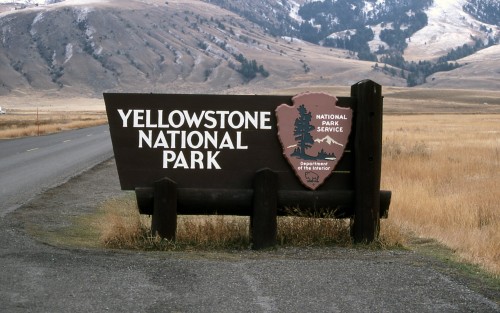 A proper ‘National Park” – Yellowstone National Park, USA A proper ‘National Park” – Yellowstone National Park, USA
© Photo by Jim Peaco, October 1992
[Source: http://www.longislandpress.com/wp-content/uploads/2011/07/14566-1.jpg]
.
One hundred and thirty nine years ago in 1872, Yellowstone National Park was established in the United States of America, leading the world in national conservation..
Australia supposedly followed suit quickly afterwards in 1879, declaring The National Park just south of Sydney the second national park in the world. It was renamed Royal National Park following Queen Elizabeth II’s visit in 1954.
But it is one thing to be seen to be following America in environmental leadership. It is publicly misleading to be disingenuous about ‘national‘ environmental protection.
 A ‘vulnerable’ Royal National Park (New South Wales, Australia)…
. A ‘vulnerable’ Royal National Park (New South Wales, Australia)…
.
National Parks in New South Wales are currently subject to the whims of incumbent State governments (both Labor and Liberal) and mining vested interests with such demands as to explore coal seam gas mining using fracking and chemical contamination from the likes of Apex Energy and Peabody Pacific’s joint Metropolitan Mine near Helensburgh in 2010.
National parks are typically large natural areas of land that are protected because they have unspoilt landscapes and a diverse number of native plants and animals. This means that commercial activities such as farming are prohibited and human activity is strictly monitored. The purpose of the ‘national parks’ concept is to protect native flora and fauna and their habitat.
 Victorian Alps Victorian Alps
.
Disturbingly, the powers that be in National Parks have grown a mindset that national parks are created primarily not for altruistic genuine conservation but for tourism – human use, benefit and exploitation. The sell is that national parks “are also there so Australians and foreign visitors can enjoy and learn about our unique environment, heritage and culture.”
Australia has over 500 national parks covering some 28 million hectares accounting for 4% of Australia’s land mass. But similarly disturbing is that the Australia legal concept of a ‘national park’ is one typically managed not by the national government, but a custodial responsibility delegated to the States and Territories of Australia. This means that across Australia, national parks are a hollow label for ‘reserve’, or in the case of Victoria’s Alpine National Park, an endless free cow paddock!
 Cattle in the Alpine National Park?
© Photo Trevor Pinder Herald Sun 20110412 Cattle in the Alpine National Park?
© Photo Trevor Pinder Herald Sun 20110412
.
The state/territory custodial role for national parks is a left-over legacy from pre-Federation colonial Australia of the Nineteenth Century, in much the same way the Crown Land is a leftover legacy from when the Australian colonies were subservient to Britain. And sure enough, the management records demonstrate that the spirit of national park protection has not been respected by the state and territory custodial governments.
National Park ‘protection’ in the United States has national clout. But in Australia the term is politically expedient and superficial. This has caused the conservation movement to increasingly look to UNESCO World Heritage, because state and territory governments cannoit be trusted. ‘National park’ status has become meaningless. Just consider the Kakadu, Kosciuszko, and the Great Barrier Reef national parks and their abuse and mismanagement legacies!
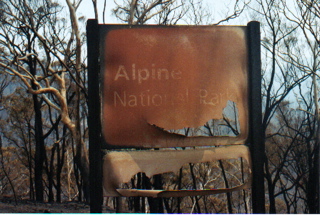 Alpine National Park
10,000 hectares was allowed to burn in 2003
~ so much for National Park ‘protection’, more like ‘abandonment’. Alpine National Park
10,000 hectares was allowed to burn in 2003
~ so much for National Park ‘protection’, more like ‘abandonment’.
.
.
Media Release by the National Parks Association of NSW:
[22 July 2011]
.
‘National Parks to be given national status’
.
National Parks Association of NSW CEO, Kevin Evans, has welcomed moves by Federal environment minister Tony Burke to add Commonwealth protection to Australia’s national parks.
“Stronger Federal protection for national parks is a groundbreaking move that will ensure the long-term integrity of Australia’s most loved natural places and vital habitat for threatened plants and animals,” Mr. Evans said.
“It will also make sure that politically motivated interference in park protection, including proposals for inappropriate tourism infrastructure, mining, cattle grazing and hunting will be more difficult in the future.
“We need to be clear that such proposals are not in the national interest,” Mr. Evans said. “Our protected areas are part of much bigger systems working at a landscape scale as the corner stone of Australia’s biodiversity conservation strategy.”
Speaking at the Sydney Institute on Thursday evening, Mr. Burke said “that there was a principle that once an area was protected there shall be no backward steps”.
He referred to the move by the Victorian government to return cattle to the Alpine National Parks earlier this year as treating a national park like a farm.
“Importantly, if implemented, this proposal would allow Australia to honour its commitment to international treaties designed to protect the world’s natural heritage” Mr. Evans said.
“It won’t change the way national parks are managed but as the minister says, it will make sure that there will be ‘no backward steps’ in that management.
“Most people already assume that national parks have national protection, as they do in most countries of the world. But almost all of our most important natural areas are actually set up and managed under the laws of each state and territory.”
Minister Burke announced last night that he has written to all states and territories seeking their views on a plan to amend federal laws to better protect national parks.
NPA encourages the NSW government to cooperate with the Federal environment minister on his proposal.
“Under the proposed federal law, states will still be in control of setting park boundaries, and there will be no change to existing activities in parks,” said Mr. Evans.
Mr. Evans said,
“What it does mean is that the protection offered by state laws will be backed up by national law.”
Our national parks will be truly part of our national heritage, securely protected by all Australians, for all Australians, for all time.
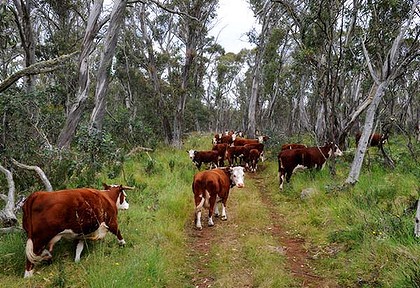
.
.
Editor’s comments:
This revelation confirms that Australians have been hoodwinked about ‘National Park Protection’ since 1879.
It one of the biggest greenwashing cons in Australian history. National Parks are but a convenient propaganda label until alternative land use demands are proposed.
The message is that the States and Territories simply cannot be trusted with Australia’s valuable natural heritage.
So if such jurisdictions are so unrepresentative of Australian values, then why do the States and Territories continue to exist?
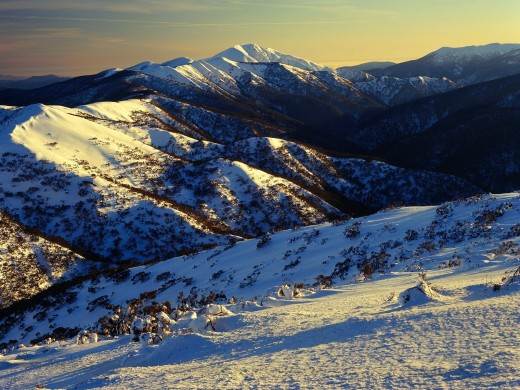 Sunrise on Mount Feathertop, Alpine National Park, Victoria
© http://good-wallpapers.com/places/4689. Sunrise on Mount Feathertop, Alpine National Park, Victoria
© http://good-wallpapers.com/places/4689.
.
.
Background:
.
‘High country ought stay a cattle no-go zone’
by Geoff Mosley, 20110308, The Age
.
‘The Baillieu government’s decision to reintroduce cattle into the Alpine National Park not only snubs 80 years of research highlighting the environmental damage they can do, it also undermines co-operative management of Australia’s alpine parks. This move was undertaken without any consultation with the federal government and, since the Alpine National Park is on the National Heritage List, all eyes are on whether Environment Minister Tony Burke will intervene to protect the area’s nationally significant natural heritage values.
 Victorian Premier, Ted Ballieu
© Sunday Herald Sun, 20110424 Victorian Premier, Ted Ballieu
© Sunday Herald Sun, 20110424
.
In deciding, Burke must take into account strong opposition to the Baillieu government’s move from the Australian Academy of Science and the World Commission on Protected Areas. These organisations have pointed to the bad example it would set when more than 3000 people attend the World National Parks Congress in Melbourne in 2014.
The planned ‘‘study’’ was also criticised by Melbourne University’s School of Land and Environment, whose acting head, associate professor Gerd Bossinger, said in an email: ‘‘much of the work being proposed has already been done’’. This response elicited a threat from the Baillieu government over millions of dollars in research funding.
Burke should also consider the damage that Victoria’s action would do to the co-ordinated approach to interstate management of the alpine parks, which has operated since 1986.
The states have been in charge of public land, including national parks, which by then had been established in several states, since Federation in 1901. Federation also introduced a possible role for the federal government in encouraging co-operative endeavours in heritage protection.
Co-operation did not come easily. The first initiative for a cross-state national park in the Alps came from the environment movement.
But, in 1943, the Victorian government rejected the proposed ‘Snowy-Indi National Park‘, embracing parts of the NSW (17,200 ha) and Victoria’s high country (22,000 ha), because of the ‘‘dangers to which large areas of country would be exposed by prohibiting occupation’’ – whatever that meant.
Instead the individual states established separate protected areas in their territories – Kosciusko State Park in 1944 (which became Kosciusko National Park in 1967), Gudgenby Nature Reserve in 1979 (became Namadgi National Park in 1984), and the Alpine National Park (formed from several disparate parks) in 1989.
The case for co-operative management of these adjacent alpine parks was obvious but who would initiate it?
The potential for Commonwealth leadership in such an enterprise was greatly increased in the 1970s with the passage of legislation to protect the national estate and with Australia’s ratification in 1974 of the World Heritage Convention. Apart from Queensland’s Great Barrier Reef and south-west Tasmania, there appeared to be no part of Australia more deserving of such a federal commitment than the Alps.
A clear case in point was the need for a uniform approach to alpine grazing. NSW ended the practice in Kosciusko National Park in 1969. The ACT followed suit. But the Victorian government dithered. So in 1984, I, as then director of the Australian Conservation Foundation, took 15 Victorian MPs on a tour of Kosciusko National Park. The visitors were so impressed by the recovery of the land after the removal of grazing that they agreed on a ‘‘Memorandum of Understanding for Co-operative Management of the Australian Alps National Parks’’, signed on July 15, 1986.
After an extensive review, in 2006 the Victorian government terminated the last of several of grazing licences in the Alpine National Park, bringing the state into line with NSW and the ACT. The Baillieu government’s reintroduction of grazing puts this hard-won co-operation in jeopardy.
Tony Burke’s decision also has consequences for the fate of the world heritage-listing proposal, in limbo since prime minister Bob Hawke announced in 1989 that the Australian Alps would be assessed.
World heritage listing of the Alps and adjacent forests – the ‘‘sea to snow concept’’ – would give the federal government enhanced power to act as Hawke did in 1983 to stop the Franklin Dam in Tasmania’s Wilderness World Heritage Area. Five reports later and nothing has happened. Meanwhile, the presence of cattle in the Alpine National Park could mean that a nomination would fail the ‘‘integrity’’ test for listing.
Burke has an opportunity to not only protect the Alpine National Park but to advance the overall cause of national heritage protection. If the word ‘‘national’’ means anything, he must do the right thing by the people of Australia and send the cattle back down the hill.’
– – – – – – – – – –
[Geoff Mosley has been involved with establishing and management national parks in the alpine areas of ACT, New South Wales and Victoria for 50 years. He was chief executive of the Australian Conservation Foundation from 1973 to 1986 and remains a member of the ACF council.]

.
.
.
Further Reading:
.
[1] ‘Burke demands a halt to alpine cattle grazing‘, 20110318, ABC Rural, ^http://www.abc.net.au/rural/news/content/201103/s3167854.htm
[2] ‘High country ought stay a cattle no-go zone‘, by Geoff Mosley, 20110308, ^http://www.smh.com.au/opinion/high-country-ought-stay-a-cattle-nogo-zone-20110307-1bka1.html
[3] ‘ Cattle Don’t Belong in Parks‘, Victorian National Parks Association ^ http://vnpa.org.au/page/bushwalking-and-activities/events/public-meeting-_-cattle-don%27t-belong-in-parks
[4] ‘ Coal Seam Gas Mining Threatens NSW and Australia‘, ^ http://www.stopcoalseamgas.com/helensburgh.php
[5] ‘ Wildlife under threat from shooters in NSW‘ (National Parks), ^ http://www.animalsaustralia.org/take_action/wildlife-under-threat-from-shooters–in-NSW/
[6] ‘ Uranium mining in Kakadu National Park‘, ^ http://en.wikipedia.org/wiki/Uranium_mining_in_Kakadu_National_Park
[7] ‘ Great Barrier Reef Environmental Threats‘ ^ http://www.workincairns.com/great-barrier-reef/environmental-threats.asp
[8] ‘ Human Impact on the Great Barrier Reef‘, University of Michigan, ^ http://sitemaker.umich.edu/gc2sec7labgroup3/pollution
.
(All references accessed 20110722)
.
22 July 2011
National Parks to be given national status
National Parks Association of NSW CEO, Kevin Evans, has welcomed moves by Federal environment minister Tony Burke to add Commonwealth protection to Australia’s national parks.
“Stronger Federal protection for national parks is a groundbreaking move that will ensure the long-term integrity of Australia’s most loved natural places and vital habitat for threatened plants and animals,” Mr. Evans said.
“It will also make sure that politically motivated interference in park protection, including proposals for inappropriate tourism infrastructure, mining, cattle grazing and hunting will be more difficult in the future.
“We need to be clear that such proposals are not in the national interest,” Mr. Evans said. “Our protected areas are part of much bigger systems working at a landscape scale as the corner stone of Australia’s biodiversity conservation strategy.”
Speaking at the Sydney Institute on Thursday evening, Mr. Burke said “that there was a principle that once an area was protected there shall be no backward steps”. He referred to the move by the Victorian government to return cattle to the Alpine National Parks earlier this year as treating a national park like a farm.
“Importantly, if implemented, this proposal would allow Australia to honour its commitment to international treaties designed to protect the world’s natural heritage” Mr. Evans said.
“It won’t change the way national parks are managed but as the minister says, it will make sure that there will be ‘no backward steps’ in that management.
“Most people already assume that national parks have national protection, as they do in most countries of the world. But almost all of our most important natural areas are actually set up and managed under the laws of each state and territory.”
Minister Burke announced last night that he has written to all states and territories seeking their views on a plan to amend federal laws to better protect national parks.
NPA encourages the NSW government to cooperate with the Federal environment minister on his proposal.
“Under the proposed federal law, states will still be in control of setting park boundaries, and there will be no change to existing activities in parks,” said Mr. Evans.
Mr. Evans said, “What it does mean is that the protection offered by state laws will be backed up by national law. Our national parks will be truly part of our national heritage, securely protected by all Australians, for all Australians, for all time.
“It will be good for nature protection and good for ecologically sustainable tourism,” said Mr. Evans.
Tags: Alpine National Park, Baillieu government, Cattle in the Alpine National Park, Cattle no-go zone, national parks, National Parks Association of NSW, NPA, Tony Burke, Victoria's High Country, World National Parks Congress 2014
Posted in Australian Alps (AU), Threats from Farming, Threats from Greenwashing, Threats from Mining, Threats from Tourism and Recreation | No Comments »
Add this post to Del.icio.us - Digg
Friday, July 22nd, 2011
The following article was initially posted by Tigerquoll 20090408 on CanDoBetter.net:
.
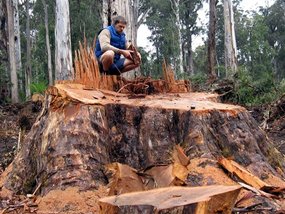 © Photo EEG 2009 © Photo EEG 2009
.
Radiocarbon-testing has confirmed that a giant rare old-growth Eucalyptus regnans located in its natural forest habitat on East Gippsland’s Brown Mountain has been chainsawed by VicForests, despite it being scientifically confirmed to be at least 500 years old.
No regard has been made for the existence value of a Victorian 500 year old natural asset, nor the habitat requirements for the typical arboreal animals and forest owls dependent on this old growth habitat tree or its associative forest dependent habitat. Under State-
sanction, ignorant VicForest butchers have plundered, ransacked and run.
 © Photo EEG 2009 © Photo EEG 2009
.
Manager, Victorian Department of Sustainability and Environment, Orbost, Steve DeVoogd, has been formally advised that this chainsawing of rare old growth forest is an offence committed under the section 46(1) of the Sustainable Forests (Timber) Act 2004. The action is also a breach of Code of Forest Practices (CFP). VicForests Chairman, Warren Hodgson, Board members Monica Gould, Jim Houghton, Fiona McNabb, Bob Smith, Susan Walpole, and Chief Executive Officer David Pollard should all be sacked forthwith. VicForests token ‘vision’ ‘purpose’ and ‘values’ which profess motherhood notions of ‘sustainable’, ‘environmentally responsible’ and ‘ethical’ are but ‘Mugabean’. This 500 year old tree epitomises the reality of Brumby’s ‘Sustainability Charter for State forests.
Botanist Steve Mueck has worked for the Victorian Department of Natural Resources and Environment and is now a consultant in the private sector. He says radiocarbon dating of eucalypts is unusual and the result in this case is significant.
“Current forest managements practices are looking at harvesting on rotation times in the vicinity of 80 to 120 years with the perception that that’s a particularly long period of time,” he said.
“Now it is, I suppose, in the context of a human lifetime, but it is a very, very short period of time in comparison to the age in which many of the components that live in these forests can in fact get to in a natural system.”
Back in the 1860s timber workers and naturalists emerged from the forests with stories of massive trees towering to immense heights and as wide as houses.
Government botanist Ferdinand von Mueller recounted the existence of a tree as high as the Egyptian Pyramids at 480 ft (144m) and another fallen tree in the Dandenong Ranges over 400 ft (120m). A giant was sighted in the Otways with a girth of 64 ft (19m).
VicForests senseless decapitation of one of the last Victorian giants is a harbinger of extinction to Victoria’s old growth forests.
It’s like grabbing an old ANZAC from a ‘march past’ and slitting his throat.
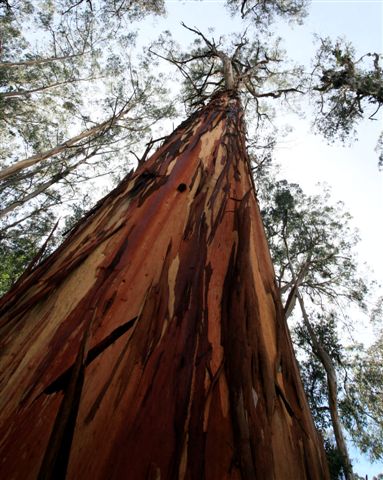 © Photo EEG 2009 © Photo EEG 2009
.
.
Comments:
.
‘Victorian Labor’s “sustainable” principles are thin and shallow’
by Vivienne 20090410:
.
In 2006 the Labor Party pledged to “protect remaining significant stands of old growth forest currently available for timber harvesting by including them in the National Parks and reserves system”.
This promise was blatantly broken.
The trees on of Brown Mountain have not burned for 200 years despite repeated fire threats. The resistance of these old forests to bushfire is evident. This area is also the home of several highly endangered native species.
Clear felling of old growth forests has continued despite their critical role in storing carbon and providing water for the depleted Snowy River catchment.
The Victorian government states that 90% of our forests are preserved. However, only 16% of Victoria is protected, and over 80 percent of what is logged in East Gippsland ends up as mere woodchips!
Clearing 10% of our forests is plainly too much considering that Victoria remains the most cleared and damaged State of Australia.
Our Brumby government is guilty of serious eco-destruction and policy violation, and any claims of “sustainable” principles are demonstrated to be thin and shallow.
.
– end of article –
Tags: biodiversity, Brown Mountain, Brumby's 'Sustainability Charter for State forests, Code of Forest Practices, deforestation, Department of Sparks and Embers, East Gippsland logging, John Brumby, save our forests, Sustainable Forests (Timber) Act 2004, VicForests, Victoria's old growth forests, Victorian Department of Sustainability and Environment, Victorian Labor
Posted in Gippsland (AU), Threats from Deforestation | No Comments »
Add this post to Del.icio.us - Digg
Wednesday, July 20th, 2011
The following article was initially posted by Tigerquoll on 20090326 on CanDoBetter.net:
.
On Thursday 26th March 2009, four people were charged in their efforts to save East Gippsland old growth forests at Upper Delegate River from being chopped down.
 ‘The Goongerah Blockade’ ‘The Goongerah Blockade’
Protesting against logging of old growth forests in East Gippsland
….prepared to be arrested for habitat.
March 2009.
eco-warriors all!
.
Conservationists trying to conserve protected old growth forests have been charged with illegal conservation. Is Victorian Premier Brumby’s strongman stance seeking to emulate Mugabean democracy?
Is Brumby’s hypocritical law for conservationists that of prima facie guilt of conservation? Surely the need to conserve rare and remnant old growth forests makes conservation self-evident?
Premier Brumby’s DSE and VicForests under their own laws maintain these catchment forests under environmental protection legislation. Yet in breach of their own laws, Brumby’s environmental watchdogs have become lapdogs, watching loggers irreparably destroy these centuries-old Eucalypts and lay witness to Victoria’s disappearing natural heritage. It’s no different to Indonesia condoning destruction of Sumatran and Kalimantan rainforests.
When was the last time Brumby bushwalked through old growth Gippsland? Last year, or never?
A dedicated group of 20 forest conservationists prevented clearfelling in the upper Delegate River catchment up until now. “This particular old growth forest was recently surveyed by trained biologists and the result showed very high density of tree dwelling mammals”, said spokesperson for the group Carmel Roberts.
“The DSE is neglecting their responsibilities to protect endangered wildlife habitat, even though it clearly states in their Forest Management Plan that where high numbers of threatened species are found, habitat must be protected.
“The DSE are saying they are unable to protect these species’ habitat despite the logging being in clear breach of their legal obligations. The government puts more value on a months work by a few people than protecting endangered wildlife from extinction.
“In 2006, Premier Brumby made an election promise to protect the “last significant stands of old growth”. These forests are the very the last refuges for our rare species.”
“Since the devastation caused by the bushfires, East Gippsland’s forests are now even more critical to the survival of Victoria’s native species than before. Rare native wildlife could have been made locally extinct in other areas due to the fire damage.”
“Old growth forest habitats such as hollow-bearing trees, are critically important for the survival of these threatened species in Victoria. The logging industry can survive in plantations and regrowth, endangered wildlife can’t.”
.
.
Comments:
.
Woodchip mafia has Brumby well trained
March 28th, 2009 by ‘Blackdog’:
.
The Brumby government is truly the lapdog to the loggers. The woodchip mafia has him well trained. The rule book says the threatened species have to be saved. He destroys them and their habitat. The promise back in 2006 was to save the old growth – but all he’s done is cover for the increased targeting of prime areas.
Yep – no different to Indonesia or the Amazon. Only Brumby employs better media spin experts. Pity the public don’t wear it.
.
.
Lap dog governments are following Easter Island
On March 28th, 2009 Tigerquoll says:
Blackdog’s comments hit the mark.
I go further than black dog.
Lap dog governments are supporting destructionist loggers while publicly advocating environmental protection in another department.
This is gross hypocracy, a conflict of interest and corrupt.
I worry also that as more clever HSC graduates take on degrees in ‘communications’, which so frequently entices them into well paid jobs in government and corporate spin machines, that pure ethics is neglected at both senior school and at most university courses.
By denying our children skills and wisdom in worldly ethics, our children are being denied their rights to cope with ethical decisions. A degree without a base in ethics is a degree in propaganda, and don’t our lapdog governments lap them up?
Take the following example and ask why in our education system and supposed independent journalism, that Australians are more aware of the extremely rich celebrities than the natural and indigenous exploitation and neglect condoned by governmenst in Australia’s World region?
SOURCE: www.drmartinwilliams.com/conservation-and-environment/indonesian-forest-destruction-corruption-plays-a-role.html
“Since 1982, forest fires on a large scale in Kalimantan, Sumatra and Java have come with the onset of each dry season. A fire in Kalimantan in 1983, reportedly the largest in human history, destroyed 3.7 million hectares of rainforest, an area the size of the Netherlands.
In 1987, 2 million hectares, 1.4 million of primary rainforest, were destroyed in Kalimantan, Sumatra, East Timor, Sulawesi and mountain regions of Java.
In 1991 smoke and ash from fires blanketed Singapore, Malaysia and the Straits of Malacca, forcing Indonesia to call for international help.
Forest fires of this magnitude coincide with a rapid increase in logging and plantation activities which began in the early 1980s. In 1966, 82% of Indonesia’s land mass was covered by primary forest. By 1982 this had shrunk to 68%, and recent satellite photographs indicate that forest cover – including timber plantations – is now down to about 55%.
In late 1996, the Indonesian minister of forests said that 20 million hectares of forest were in a critical state and warned that this was increasing rapidly. The World Bank estimates 800,000 hectares of forest are lost each year.
Around 64 million hectares – one-third of Indonesia’s land mass – is devoted to commercial logging. In 1996 Indonesia became the world’s largest plywood exporter.
…
On September 9, Suharto reissued a 1995 ban on burning forest and called on the military to help enforce it. Companies were given until October 3 to prove they were not the culprits.
Laws allow up to 10 years’ imprisonment and a 100 million rupiah fine for polluters. Not one company, however, has ever been convicted. Even the environment minister, Sarwono Kusumaatmadja, admitted to Reuters on September 22 that environmental laws are not policed properly.
Soon after Suharto’s announcement, the number of fires increased, as companies rushed to clear as much land as possible before the deadline. Even if the deadline was strictly adhered to, it would only let companies finish clearing land at a time the normal rainy season would have forced them to do so.
…
But it is not just the greed of Suharto and the logging and plantation firms which has created this disaster.
Government investment and development policies which have promoted destructive land clearing practices are spurred on by market forces and capitalism’s endless drive for profit. Many of the projects were championed by and funded by institutions such as the World Bank and the IMF, which pressure countries such as Indonesia to increase exports.”
In 2009, we must learn from Easter Island’s ancient community and its unsustainable culture of nature exploitation which ended up condemning its civilization to extinction. Else, despite our iPods, in 2009 we risk the same fate.
.
.
Injustice rules the forests
March 30th, 2009 by Sheila Newman:
.
About time this shameful situation got coverage. I would like to see a story for EVERY charge against conservationists on candobetter.
It is quite true, as you say, that the Victorian Government frequently breaks the law in its forest activities. In fact it has practically torn up its own rule book.
Keep fighting!
.
– end of article –
Tags: Carmel Roberts, clear felling, conservationists charged, East Gippsland, Goongerah Blockade, John Brumby, Logging, old growth forests, Premier Brumby, tigerquoll, Upper Delegate River, VicForests, woodchip
Posted in Gippsland (AU), Threats from Deforestation | No Comments »
Add this post to Del.icio.us - Digg
Tuesday, June 14th, 2011
 This is a Tiger Quoll (Dasyurus maculatus) This is a Tiger Quoll (Dasyurus maculatus)
Photo courtesy of Sean McClean.
.
It is Australia’s largest carnivorous marsupial on the mainland and it has become endangered because of humans destroying its habitat, shooting it and poisoning it.
It is not a cat. Much information may be obtained online simply by typing ‘tiger quoll’ on Google.
.
.
.
The following extract is from the website ‘Convict Creations‘ (15-Feb-2010):
‘Tiger Quoll…the next to die’
“Without disrespecting the Koala or Kangaroo, the Tiger Quoll is one of Australia’s most interesting animals. It sort of resembles a cat except it has a pouch, bright eyes, a moist pink nose and a powerful bite. It can grow to up to 75 cm in length and weigh up to 7kg. If trained, it will even use a kitty litter tray.
The Tiger Quoll is the type of animal that tourists would love to see on their Australian safari.
Unfortunately, they are quite rare so few have ever caught a glimpse of them.
European colonisation of Australia could have been great for the Tiger Quoll. With Europeans introducing rabbits, rats and mice, the Quoll saw a drastic increase in its food source. Had the colonists warmed to them, then a mutually beneficial relationship could have formed. Farmers could have encouraged Quolls to take up residency in order to keep rodent numbers down with little fear that their livestock would be in danger. As an added bonus, by eating carrion, the Quolls would have reduced the threat of blowfly strike.
Alternatively, they could have just made pets out of the Quoll. Apparently the Quoll has all the positive characteristics of a cat or dog. According to Professor Mike Archer, Former Director of the Australian Museum, who once kept a Quoll as a pet:
“I just can’t praise these animals highly enough as companions for human beings. They have all the good features in dogs and cats, and in my experience not a single downside”.
If colonial owners had taken care of their Quolls, then both Quoll and owner would have been happy. If not, the Quoll would have just escaped and done Australia a service by cleaning up decaying meat, rabbits and other introduced vermin.
Unfortunately, colonists never formed mutually beneficial relationships with the Quoll. Instead, they introduced the cat to serve the role of pest controller. For more than a century, farmers deliberately released cats onto their properties in order to control rabbit and mice populations. Once the cats went feral, they started to compete with the Quoll for food. Although the Quoll was better adapted to Australia’s cycle of droughts, the cat’s symbiotic relationship with humans proved to be an even better environmental adaptation. If feral cats were ever wiped out in a drought, or declined for whatever reason, they still had the family home as an oasis in the desert. From the family home, they were well placed to repopulate the bush once good conditions returned.
Even worse than competition from the cat were the environmentalists’ attempts to “help” them. The use of 1080 poison has been one of the main helping strategies. When it is used to kill rabbits, it indirectly deprives Quolls of food. So much so, by killing rabbits, human deprive Quolls of even more food than is lost due to competition by cats. To compound matters, when 1080 poison is used to kill the cats and foxes competiting with Quolls, it also ends up being eaten by Quolls. In fact, Quolls are more likely to eat the poisons because they have a keen nose for carrion while the feral predators prefer fresh kills.
A very odd example of the misguided environmental policy was recently seen in in Tasmania. 1080 was first used to reduce rabbit numbers. A rumour then developed that foxes had finally established a breeding community in the island state. Even though it was just a rumour, to be on the safe side, environmentalists decided a large scale baiting regime needed to be implemented to eradicate foxes as well. On the State Government’s own data, more than 140,000 poison baits were laid. So far, there has been no evidence that foxes were actually present. There was; however, plenty of evidence of Quoll dying!
The odd wilderness protection policy caught the attention of David Obendorf, a vet with a research focus in marsupial diseases. According to Obendorf:
“Three Tasmanians have each offered $1,000 fox rewards (Tasmanian Times: “$1,000 fox reward”). All remain unclaimed despite farmers, landowners and professional shooters all knowing about them. And yet the government “guessimate” claims there are up to 400 foxes living in Tasmania … somewhere. In my opinion Tasmania’s use of 1080 poison over the last five decades – to kill browsing and grazing native herbivores – has had a significant effect on the over-population followed by the facial tumour disease-crash in devil numbers and in the widespread establishment of feral cats across the island….Ironically the state government has now ceased the use of 1080-laced carrot/apple baits on public lands to kill grazing wildlife but now uses tens of thousands of meat baits in public forests where they claim they are targeting those cryptic foxes.” (1)
The use of 1080 poison could be legitimately referred to as Australia’s dumbest environmental policy since the construction of a 1,833 km fence to “keep” rabbits out of WA. It seems that Western Australians weren’t smart enough to realise that rabbits can dig under fences. All that was required was for a single pregnant female to dig a hole and then 1,833 km of fence line would be obsolete. Perhaps WA politicians did in fact realise the folly of it all, but decided it was more to important to show they were “doing something”.
As an added bonus, “doing something” kept people in regional Australia employed. Perhaps 1080 poison is used for similar reasons. Unfortunately, “doing something” to help Quolls is really not helping them at all. It forces them into wilderness reserves where scientists can erect huge fences to keep out ferals and then make a lucrative income maintaining them. (2)
Even though the Tiger Quoll is mainland Australia’s largest native predator, Australia doesn’t have any professional sporting team named after them. In fact, they don’t really exist in public consciousness in any significant shape or form. Perhaps this is because Quolls spend their time out in the bush where they are only ever seen by rangers.
Alternatively, perhaps the name Quoll just isn’t scary enough.
Zoos – The only real industry is as a research subjects by scientists, or to provide an endangered animal story that can be used by wilderness groups to write emotive appeals asking for funding to save them.
Pest controllers – Potentially, Quolls could make great pest controllers. They could compete with cats and foxes for food, and eliminate rabbits and rats in the process. Landowners could breed them and sell them as a substitute to 1080 poison.
Pets – Sometimes scientists have made great pets out of Quolls. At present, the general public is not allowed to do likewise. The general argument is that Quolls require special care that only a scientist can give. Consequently, Australians have to reserve their abusive ownership methods for dogs and cats that simply go bush if they are unhappy with their owners.”
.
.
The Snowy River is a surviving stronghold of the Tiger Quoll
.
“In East Gippsland, the areas on the Errinundra Plateau, Snowy River and Tingaringy are strongholds of the Spot-tailed Quoll”. (GECO)
“The Upper Snowy River and its tributaries was the Victorian stronghold of the Tiger Quoll before (the 2003) devastating Alpine bush fires. The Tiger Quoll is believed to have lost up to 75% of an estimated population of 1,000 in the area.
Following the devastating effects of recent bush fires The Tiger, or Spotted-tailed Quoll (Dasyurus maculatus) has been reclassified as nationally endangered. it is feared that the fires will have a lasting effect on the Quolls that remain.”
.
.
.
References:
[1] ABC, ^http://www.abc.net.au/rn/science/earth/stories/s145805.htm
[2] David Obendorf – ^http://www.animal-lib.org.au/news/1080–the-real-killer.htm”
[3] ^http://www.fame.org.au/current_projects.html
.
~ article by Tigerquoll, first published on CanDoBetter.net 15-Feb-2011
Monday, June 13th, 2011
Radical Australian wildlife activist ‘Tigerquoll‘ from the popular socio-political website ‘CanDoBetter.net‘ is set to join The Habitat Advocate.
Tigerquoll, over recent years, has established a forthright and controversial online blog presence at CanDoBetter.net
Victorian-based Tigerquoll, from Suggan Buggan in Snowy River Region of Australia, says he can offer us a more southern and ‘colder’ perspective on Australian wildlife issues and threats.
Tigerquoll has expressed that he remains an angry young man resentful of those who harm wildlife and of government agencies who falsely proclaim their role of wildlife conservation and protection.
He admits a dogged resolve and a lack of diplomacy.
He feels he often attracts aggression yet feels he is misunderstood since his intentions are honorable to those he seeks to protect
Check out: Tigerquoll’s Blog
We at The Habitat Advocate welcome our new contributor and what is set to become a more activist tone for our cause for maximising wildlife respect and conservation.
Watch this space!
~ Editor
Friday, June 10th, 2011
One by one, roadside vegetation, roadside communities, and villages through the Blue Mountains are capitulating to the New South Wales Government’s agency, the Roads and Traffic Authority (RTA). One diesel-driven programme to convert a regional highway into a dangerously fast heavy trucking expressway.
The RTA is an ‘authority’ alright – a testament to when absolute authority is allowed to overrule local values at any cost.
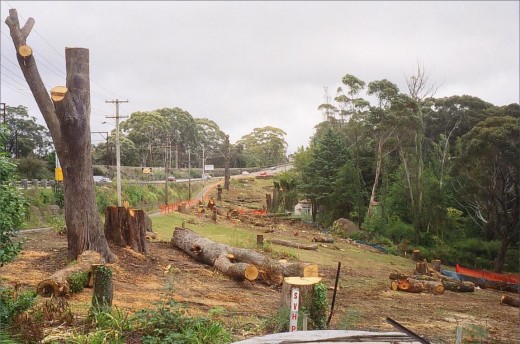 Leura, Blue Mountains, Australia, 22nd Dec 2006)
(click photo to enlarge) Leura, Blue Mountains, Australia, 22nd Dec 2006)
(click photo to enlarge)
.
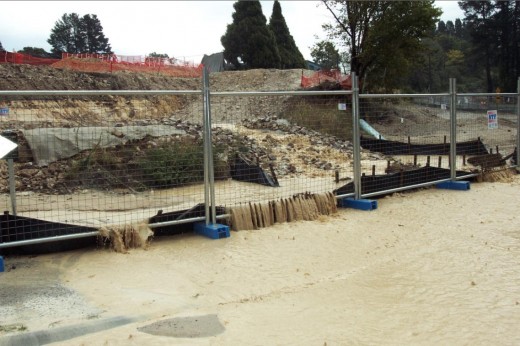 RTA rainfall retention gross failure, Leura 30th June 2005
(click photo to enlarge) RTA rainfall retention gross failure, Leura 30th June 2005
(click photo to enlarge)
.
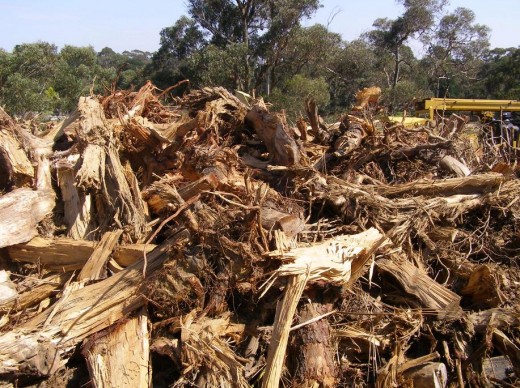 Trees hacked to make way for the RTA expressway, 4th February 2007
(click photo to enlarge) Trees hacked to make way for the RTA expressway, 4th February 2007
(click photo to enlarge)
.
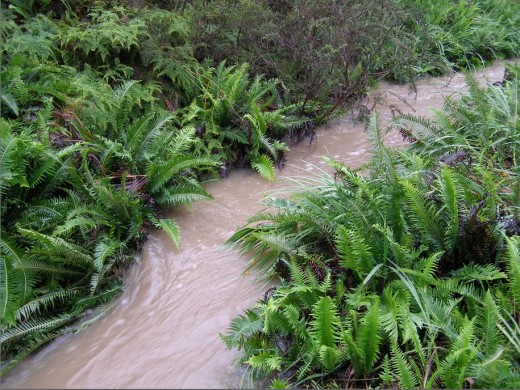 RTA construction sediment down the drain and into Blue Mountains World Heritage creeks, 16th January 2006
(click photo to enlarge) RTA construction sediment down the drain and into Blue Mountains World Heritage creeks, 16th January 2006
(click photo to enlarge)
Saturday, June 4th, 2011
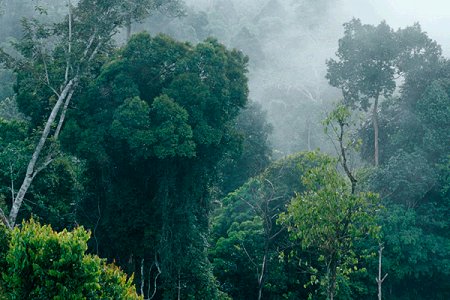
In Indonesia, bulldozing rainforest for profitable palm oil plantations for western diets has become highly profitable due to western corporate demand…


In Indonesia’s Borneo (Kalimantan) the rainforest habitat of orangutans is being destroyed, largely to make way for palm oil plantations due to western diet demand
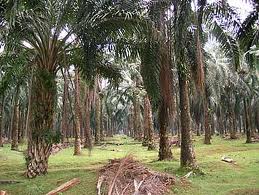
Arnott’s relies up on palm oil in its popular western ‘Tim Tam’ biscuit product

Just like these other western brands do:

The palm oil driven rainforest deforestation in Borneo (Kalimantan) thanks to unethical palm oil demand from the likes of Arnott’s…
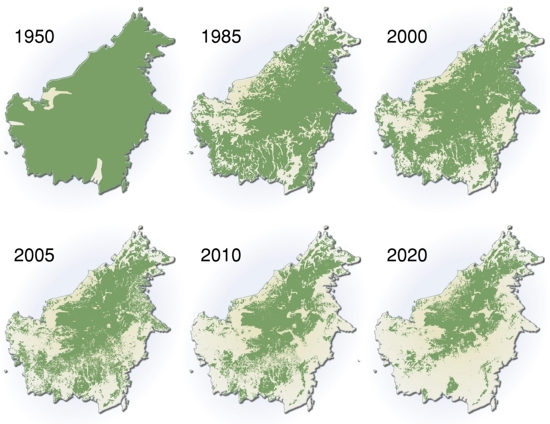
Try finding a shrinking rainforest map on the wrapper of a packet of Tim Tams!
Indonesian unethical destruction of orangutan rainforest habitat continues to provide for palm oil plantations.
This is costing the lives of about 50 orangutans every week.

Arnott’s knows this, yet continues to buy the palm oil and drive the Indonesian palm oil deforestation.

Arnott’s is expanding its sales of palm oil Tim Tams with new product offerings:

2011 has been declared by the United Nations as the International Year of Forests.
Arnott’s knows this.
 It won’t be long before human demand for Tim Tams and other palm oil consumer products have driven the orangutan into extinction. It won’t be long before human demand for Tim Tams and other palm oil consumer products have driven the orangutan into extinction.
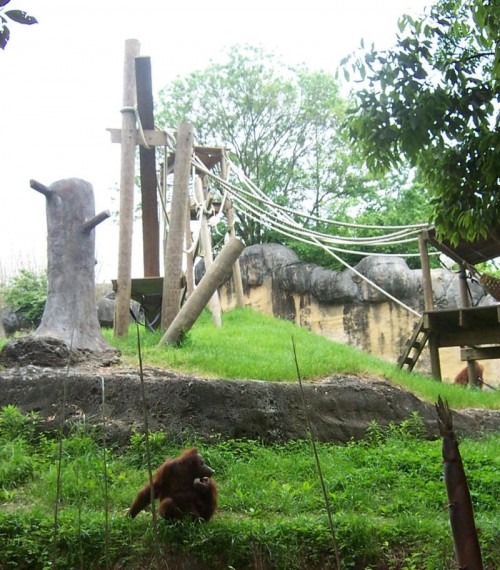
Tim Tams have become the western addiction driving orangutan extinction.
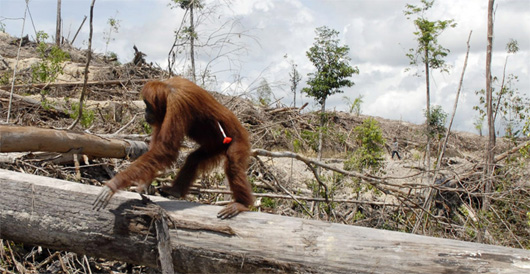
Arnott’s chocolate biscuits are more than a weight gaining guilt.
You eat them, you kill a species.


Will someone make clear to the Arnott’s Board that for Orangutans THERE IS NO SUBSTITUTE FOR QUALITY HABITAT.
Tags: arnott's, Borneo, fragile forest ecosystems, Kalimantan, no substitute for quality habitat, orangutan, palm oil plantations, pringle orphans, rainforests, tim tam, tim tam orphans, UN International Year of Forests, World Environment Day 5th June
Posted in Kalimantan (ID), Orang-utans, Threats from Deforestation, Threats from Farming | No Comments »
Add this post to Del.icio.us - Digg
Thursday, June 2nd, 2011
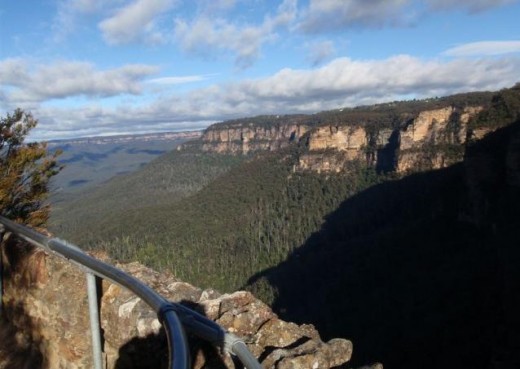 Jamison Valley from Sublime Point, Leura
(Blue Mountains, New South Wales, Australia) Jamison Valley from Sublime Point, Leura
(Blue Mountains, New South Wales, Australia)
.
For those who have purchased an escarpment-edge bush block in Blue Mountains villages of Leura, Wentworth Falls or Katoomba, who have ‘arranged‘ for native escarpment habitat to be killed in order to gain property views to the magnificent Jamison Valley, such actions are selfish and contribute to the ecological vandalism and disappearance of important and scarce escarpment habitat.
For others enjoying the Jamison Valley naturally on foot, to look back up at the Leura escarpment has become an ugly one dominated by increasing housing development.
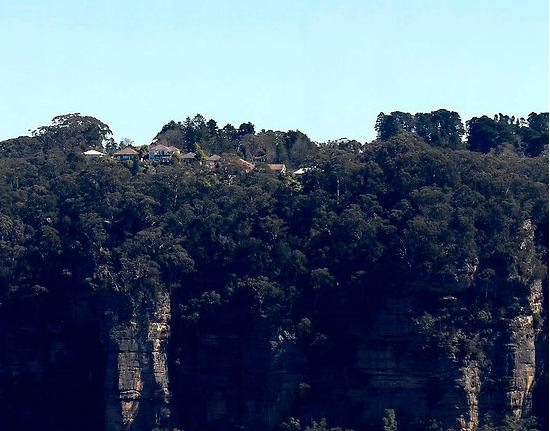
Views are bidirectional, but try explaining that to a property developer or to those real estate agents who only appreciate the sales commission.
On the spectacular escarpment fringe of the much valued village of Leura in the much valued Blue Mountains, not only have the fire-lighters taken a fancy at setting fire to nearby prized escarpment bushland, but the property developers have been in with the bulldozers.
The Blue Mountains (city) Council has for decades signed off on developer applications for clifftop development and consequential deforestation. More recently, Blue Mountains (city) Council continues to happily signed off on approval of applications from subsequent clifftop property owners to ‘hazard reduce’ the surrounding escarpment bushland ~ either to improve the views or to save money having to bushfire protect their properties.
Either way, valuable limited habitat along the Blue Mountains escarpment overlooking the Jamison Valley continues to disappear for new selfish housing views.
All along the Jamison Valley escarpment, the following photos tell a tragic story of the selfish developer destruction of the Jamison Valley Escarpment …
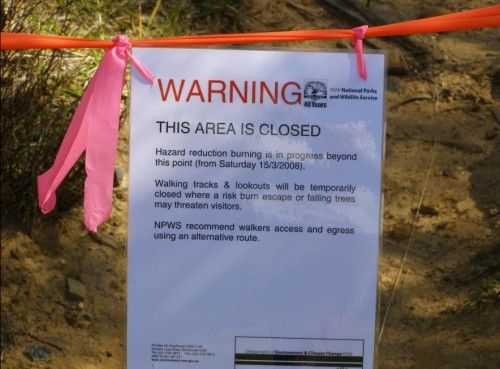 Wildlife Service ‘hazard reduction’ burn notice for Sublime Point escarpment at the end of Willoughby Road, Leura back on 15th March 2008.
(click photo to enlarge) Wildlife Service ‘hazard reduction’ burn notice for Sublime Point escarpment at the end of Willoughby Road, Leura back on 15th March 2008.
(click photo to enlarge)
.
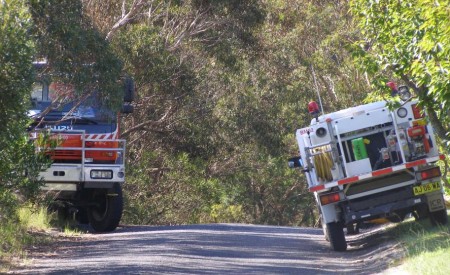 Warrimoo Rural Fire Service set up to conduct hazard reduction at Sublime Point, Leura (Carleton Road, Leura, 15th March 2008). Warrimoo Rural Fire Service set up to conduct hazard reduction at Sublime Point, Leura (Carleton Road, Leura, 15th March 2008).
.
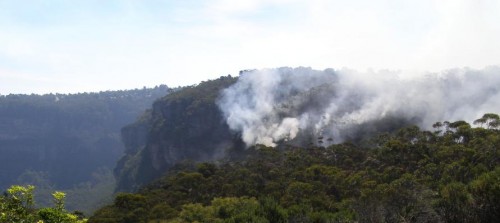
Rural Fire Service setting fire to escarpment vegetation at Sublime Point on the Jamison Escarpment, Leura. (Photo from Willoughby Road,Leura, 15th March 2008).
.
A year later again at Sublime Point…
.
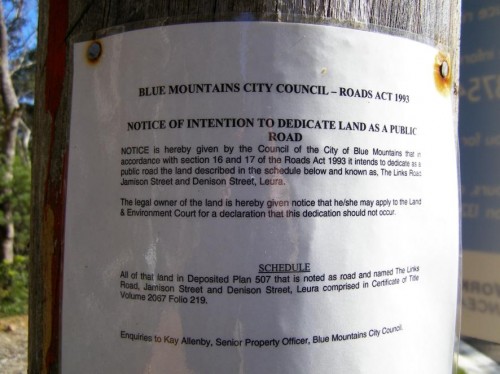 DECC Wildlife Service ‘hazard reduction’ burn notice for Sublime Point escarpment again on 24th March 2009, almost exactly a year to the date. DECC Wildlife Service ‘hazard reduction’ burn notice for Sublime Point escarpment again on 24th March 2009, almost exactly a year to the date.
.
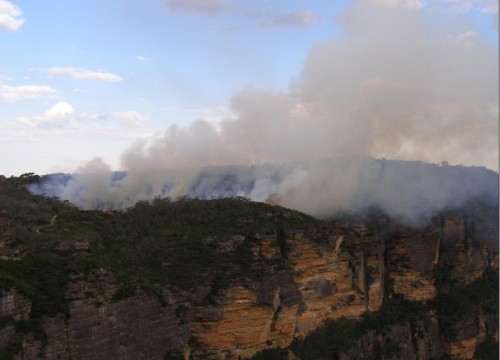 Blue Mountains Wildlife Service ‘hazard reduction’ burn of the Jamison Escarpment at Sublime Point 24th March 2009 Blue Mountains Wildlife Service ‘hazard reduction’ burn of the Jamison Escarpment at Sublime Point 24th March 2009
.
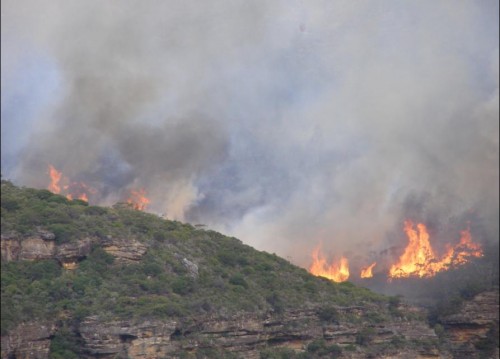 Blue Mountains Wildlife Service ‘hazard reduction’ burn of the Jamison Escarpment at Sublime Point 24th March 2009. Blue Mountains Wildlife Service ‘hazard reduction’ burn of the Jamison Escarpment at Sublime Point 24th March 2009.
.
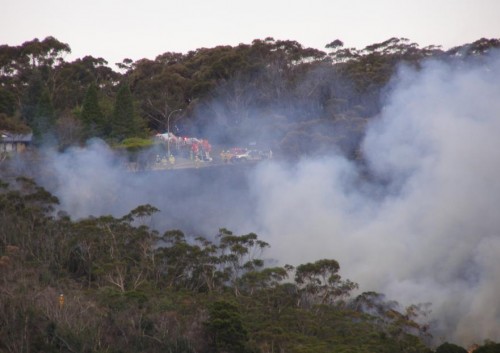 Fire-lighters watching on as their blaze gets out of control at Sublime Point 24th March 2009.
(Click photo for enlargement) Fire-lighters watching on as their blaze gets out of control at Sublime Point 24th March 2009.
(Click photo for enlargement)
.
.
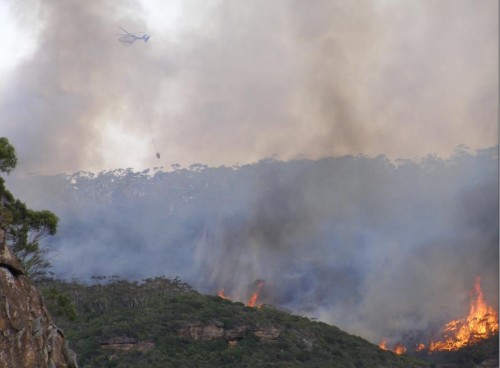 Same ‘hazard reduction’ burn out of control, requiring expensive and embarrassing helicopter water-bombing to stop the fire spread down into the protected Jamison Valley Same ‘hazard reduction’ burn out of control, requiring expensive and embarrassing helicopter water-bombing to stop the fire spread down into the protected Jamison Valley
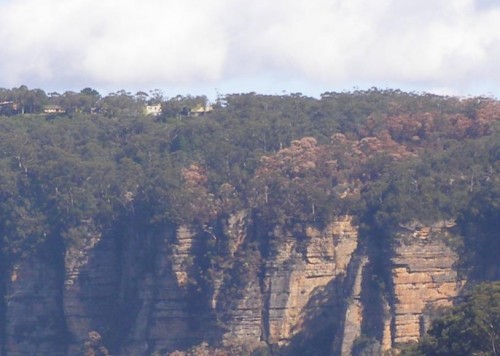 East side of Sublime Point (5th April 2009) showing burnt vegetation, where the HR burning had escaped and nearly entered down into the Jamison Valley.
(The media spin by bushfire management was that this section was arson, but not surprisingly the culprit was never found). East side of Sublime Point (5th April 2009) showing burnt vegetation, where the HR burning had escaped and nearly entered down into the Jamison Valley.
(The media spin by bushfire management was that this section was arson, but not surprisingly the culprit was never found).
.
nec.
Meanwhile, property developers at Sublime Point, a block away…
.

Leura’s recently approved and created ‘ The Links Road‘ (31st May 2008) following Council approved destruction of escarpment vegetation and subsequent subdivision ready for escarpment housing..with views.
.
Meanwhile, further along Cliff Drive at Katoomba…
.
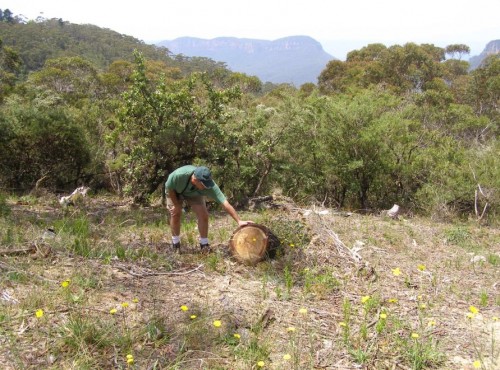 Editor inspecting native escarpment site on Cliff Drive, Katoomba back on 12th January 2008 that had been recently slashed by the Wildlife Service.
It just so happened that a house opposite on Cliff Drive was up for sale and would benefit from the fresh views of the Jamison Valley. Editor inspecting native escarpment site on Cliff Drive, Katoomba back on 12th January 2008 that had been recently slashed by the Wildlife Service.
It just so happened that a house opposite on Cliff Drive was up for sale and would benefit from the fresh views of the Jamison Valley.
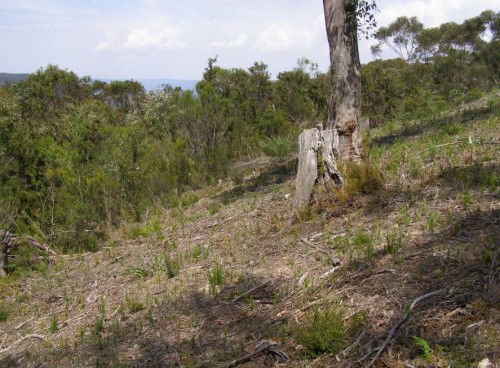 Same site, same date. Same site, same date.
.
 Seven months later, a few hundred metres west along Cliff Drive Katoomba,
some developer gets escarpment views towards Nellies Glen approved,
or is it more a case of ‘overlooked‘ by Blue Mountains (city)Council? Seven months later, a few hundred metres west along Cliff Drive Katoomba,
some developer gets escarpment views towards Nellies Glen approved,
or is it more a case of ‘overlooked‘ by Blue Mountains (city)Council?
.
.
.
-end of article –
Tags: Blue Mountains City Council, Blue Mountains western escarpment, Blue Mountains World Heritage Area, bushland housing, hazard reduction, housing encroachment, Jamison Valley, Katoomba, Leura, Links Road, NPWS, prescribed burning, Sublime Point, Wentworth Falls, Wildlife Service
Posted in Blue Mountains (AU), Threats from Bushfire, Threats from Development | No Comments »
Add this post to Del.icio.us - Digg
|
|
 A proper ‘National Park” – Yellowstone National Park, USA
A proper ‘National Park” – Yellowstone National Park, USA A ‘vulnerable’ Royal National Park (New South Wales, Australia)…
.
A ‘vulnerable’ Royal National Park (New South Wales, Australia)…
.
 Victorian Alps
Victorian Alps Cattle in the Alpine National Park?
© Photo Trevor Pinder Herald Sun 20110412
Cattle in the Alpine National Park?
© Photo Trevor Pinder Herald Sun 20110412
 Alpine National Park
10,000 hectares was allowed to burn in 2003
~ so much for National Park ‘protection’, more like ‘abandonment’.
Alpine National Park
10,000 hectares was allowed to burn in 2003
~ so much for National Park ‘protection’, more like ‘abandonment’.
 Sunrise on Mount Feathertop, Alpine National Park, Victoria
© http://good-wallpapers.com/places/4689.
Sunrise on Mount Feathertop, Alpine National Park, Victoria
© http://good-wallpapers.com/places/4689.
 Victorian Premier, Ted Ballieu
© Sunday Herald Sun, 20110424
Victorian Premier, Ted Ballieu
© Sunday Herald Sun, 20110424

















































